 Image search results - "sculpture" Image search results - "sculpture" |
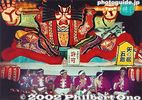
Nebuta are giant, wire-frame, paper lanterns shaped in various legendary and macho characters.The Aomori Nebuta Matsuri is held in Aomori City in Aomori Prefecture during Aug. 2-7. Nebuta are giant, wire-frame, paper lanterns shaped in various legendary and macho characters such as samurai warriors, demons, and gods. They are fantastic works of art dramatically illuminated from the inside. The floats are paraded along the main streets of the city near Aomori Station every night of the festival.
From August 2 to 6, the Nebuta parade is held from 7 p.m. to 9 p.m. On the 2nd and 3rd, the parade is geared for the many children who participate by pulling the floats. About 15 large Nebuta floats and some small Nebuta floats for the children are paraded.
The festival's peak period is from the 4th to the 6th when over 20 large Nebuta floats make their rounds. Be sure to see the festival on one of these three nights.
On the 7th, the last day, the parade is in the afternoon from 1 p.m. to 2:30 p.m. Later in the evening, the Nebuta floats are put on boats to be highlighted by a fireworks display.
The festival is designated by the government as an Important Intangible Folk Culture Asset and not to be missed if you have the chance. It's well worth the trip up north.
|
|
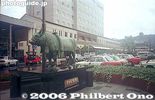
Fighting bull statue in front of Uwajima Station.
|
|
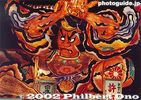
According to one story, the Nebuta has its roots in the 8th century.According to one story, the Nebuta has its roots in the 8th century when there was a rebellion in Ezo (Hokkaido). Ordered by Emperor Kanmu to quell the rebellion, generalissmo Sakanoue no Tamuramaro went to Ezo. However, he failed to capture the elusive chief of Ezo who went into hiding in the mountains.
Sakanoue then set up a trap with large votive lanterns which were lit and accompanied by taiko drums and flutes. This lured the curious Ezo chief out of hiding and led to his capture. The large lanterns were the forerunner of the Nebuta.
|
|

Statue of Takeda Shingen.
|
|

Kakegawa, Shizuoka
|
|

Statue of castle founder and 1st lord, Yuki Hideyasu 結城秀康
|
|

The Peace Statue was built in Aug. 1955, the 10th anniversary of the bombing. The Peace Statue was modeled after popular wrestler Rikidozan.
|
|

Shimizu Bank's relief of Kazutoyo and Chiyo
|
|

Baby Buddha statueLadles are provided for pouring the sweet tea over the Buddha. Sweet tea is also provided to worshippers. It symbolizes the sweet rain that fell when the Buddha was born.
|
|

Kaeru frog to wish you a safe return. 東門院
|
|

One of Japan's three Big Buddhas (after Nara and Kamakura). The statue was built by local coppersmiths in 1932, taking 30 years to complete.
|
|
|

The Takaoka Daibutsu stands 15.85 meters high, weighing 65 tons. Japan's largest copper statue. Takaoka, Toyama
|
|

Psst, wanna know a secret? Kitain Temple, Kawagoe
|
|

Kannon and bridge, Takasaki, Gunma
|
|

In fall 2007, it underwent major renovation.
|
|

Steel sculpture depicting Ishida Mitsunari giving tea to Toyotomi Hideyoshi. Ishida-cho, Nagahama, Shiga Pref.
|
|

This is a pose when Tora-san goes to the Shibamata Station and he looks back to his sister Sakura who calls him.
|
|

Sculpture in front of Takaoka Station (north side)
|
|
|

Sculpture in front of Takaoka Station (north side)
|
|
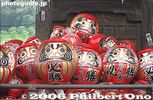
Daruma dolls can never be knocked over since they always stand upright.
|
|
|
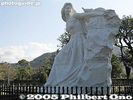
Peace memorial from ChinaThe park also has peace monuments from various countries.
|
|

Sculpture along a shopping street
|
|

Stones and Oku-no-miya Shrine
|
|

This is what you see inside Oku-no-miya Shrine. A giant wooden phallus offering.
|
|

Statue of Chiba-no-suke Tsuneshige and Chiba Castle tower 千葉介常重Lord Chiba-no-suke Tsuneshige was the founder of Chiba Castle in 1126.
|
|
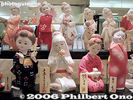
Hakata Ningyo dolls
|
|

Oku-no-miya Shrine also has many other phallic objects presented as offerings. There even one which you can touch...
|
|

Statue of Chiba-no-suke Tsuneshige built in Dec. 2001 to commemorate Chiba city's 80th anniversary. 千葉介常重Lord Chiba-no-suke Tsuneshige was the founder of Chiba Castle in 1126.
|
|

Apparently it can become erect too. (Compare with previous photo.)
|
|
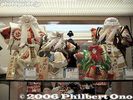
Hakata dolls are Fukuoka's most famous souvenir. There are all kinds and they suit almost any budget.
|
|

Paper plane sculpture
|
|

Phallic objects
|
|

Another sculpture in the Aviation Memorial Park.
|
|

Note that the phallus is not the object of worship. It is an offering to the god.
|
|

Sculpture at the park entrance. Sculptures of women must always be nude, it seems.
|
|
|

Daibutsu Buddha statue
|
|

Omi merchant statue.
|
|

It was believed that Indra would step in and chase away the demons causing calamities to the followers of Buddhism. Photo: Wood Carving Gallery (admission charged)
|
|

Sculpture of Tora-san's famous hat and bag
|
|

Place to rub the sacred balls. 珍宝窟
|
|

Memorial at hypocenterErected in July 1995 for the 50th anniversary.
|
|

Sculpture near the Fukushima Prefectural Museum
|
|

Sacred Monkey sculpture (Shin'enzo) holding a real banana. The monkey is Hie Shrine's messenger believed to bring marital harmony and children. 神猿像
|
|

The side and rear exterior walls of the Taishakudo are blanketed with panels of detailed woodcarvings. They are the most outstanding feature of Shibamata Taishakuten Temple.. 彫刻ギャラリー
|
|
|
|
|

Another nude sculpture.
|
|

There are ten large carvings (each 2.27 meters by 1.27 meters) depicting scenes from the Lotus Sutra (Hokekyo).
|
|
|
|
|

The woodcarvings were requested by the temple's 16th priest, Nissai. Through a generous donation from devoted follower Suzuki Genjiro, the project was begun.
|
|

Tora-san is helping to install the museum sign.
|
|

Rub the two balls.
|
|

The first panel was completed in 1922. The carver, Kato^ Toranosuke, proposed that the remaining 9 panels be carved by renown woodcarvers living in Tokyo. A large keyaki panel was delivered to each of the nine carvers.
|
|

Tora-san is helping to install the museum sign. What a great gag. Get you laughing even before you enter.
|
|

Put in money and it will make a "chin" sound. (From the word "chinpo" for penis.)
|
|
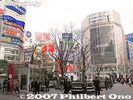
Shibuya Station, Hachiko Square
|
|

Yokozuna statue
|
|

However, in 1923, the Great Kanto Earthquake struck and these panels did not survive. A subsequent search for replacement panels was conducted nationwide.
|
|

Phallic fence posts.
|
|

In 1926, large keyaki replacement panels were finally procured and the project was back on track. The carvings were completed in 1934.
|
|
|

Statue of St. Shinran (1173-1263), founder of the Jodo Shinshu (Pure Land) Buddhist Sect.
|
|

Since such large pieces of keyaki wood are very difficult to find and the carvings are so fine, the carvings are regarded as highly valuable cultural assets.
|
|

Phallic rock. There are several phallic rocks donated by various people. Apparently they are either natural or carved.
|
|

If you want a detailed explanation (in Japanese) of the Lotus Sutra scenes depicted by the woodcarvings, buy the pamphlet that is sold at the temple's souvenir stand near the Nitenmon Gate.
|
|

Best-looking phallic rock.
|
|
|
|
|
|

Female and male rocks.
|
|
|

Behind the rocks are two trees bonded together.
|
|
|
|
|

Symbol of Ritto and Ritto Station
|
|

Statue of Emperor Keitai in Asuwayama Park 継体天皇像The 26th Emperor of Japan is said to have hailed from Echizen Province.
|
|

To protect the exterior woodcarvings from the elements and to allow visitors to view them up close, the temple built a transparent, permanent scaffolding on the side and rear exterior walls of the Taishakudo.
|
|

It makes you feel like you are in an art gallery. From the front of the Taishakudo, the scaffolding is neatly concealed from view.
|
|
|
|

Worst-looking phallic rock. That's stretching the imagination a little too much.
|
|
|

Inuyama International Sightseeing Center "Freude"
|
|
|
|
|

Toyama Castle
|
|
|
|
|
|
|
|
|
|
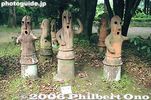
Haniwa statues in Heiwadai Park, Miyazaki
|
|

Stone buddha
|
|
|

Since the carved walls are two stories high, the scaffolding has upper and lower levels which allows you to view the woodcarvings on the upper and lower halves of the walls. This is the lower floor
|
|

Dragon
|
|

Corridor to Guest House (Dai-kyakuden)
|
|

Even the corridor has wood carvings.
|
|
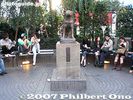
Shibuya Station, Hachiko statue
|
|

Byakkotai statue outside the Byakkotai Memorial Museum
|
|

Shibuya Station, Hachiko statue
|
|

Statue of Omi merchant peddler carrying his trademark "tenbin" pole.
|
|

Arai Kannon statue. Wash the part of the body to cure the corresponding part of your own body. 洗い観音
|
|

They used to have a tawashi brush to wash the statue, but that wore out the statue. So the replacement statue is now washed/rubbed with a towel instead.
|
|

Jizo statue
|
|

Jizo statue
|
|

Sculpture
|
|

Mother and child sculpture
|
|
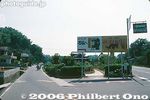
Way to the stone buddhas in Usuki.
|
|
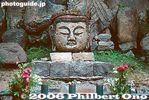
Buddha head before reattachement in 1994. 古園石仏
|
|
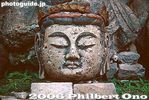
Closeup of Buddha head before reattachment in 1994. Usuki, Oita. 古園石仏
|
|
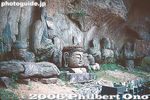
Stone buddhas in Usuki, Oita. 古園石仏
|
|

古園石仏
|
|

Stone buddhas, Usuki, Oita.
|
|
|
|
|
|

Stone buddha enclosed by a building. 山王山石仏
|
|

Popular meeting place at Shibuya Station, south exit.
|
|

Kamaishi Dai-Kannon. She holds a fish.
|
|
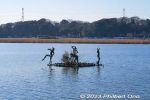
Small sculpture in Lake Teganuma, Abiko, Chiba.
|
|

Statue of Amenomori Hoshu. He is regarded as a pioneer in Korean-Japanese relations and an internationally-minded person ahead of his time.
|
|

19th Century Hall, SL & Piano Museum and sculpture of locomotive wheels.
|
|
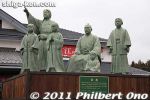
Statue of the Azai family in front of the Azai pavilion. As soon as they arrive here, most visitors take a picture of this sculpture.
|
|

Sculpture of Lady Murasaki Shikibu.
|
|

Sculpture of Lady Murasaki Shikibu at Ishiyama-dera, Otsu, Shiga.
|
|

Sculpture of Lady Murasaki Shikibu.
|
|

Bamba Chutaro Jizo-son statue, based on a character in the novel "Mabuta-no-Haha" 瞼の母 by Hasegawa Shin (1884-1963) 長谷川伸. 番場忠太郎
|
|

Statue of Toyotomi Hideyoshi, Nagahama Castle, Shiga. He renamed the town from Imahama to "Nagahama" after his boss and mentor Oda Nobunaga.
|
|
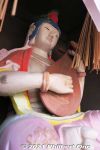
Statue of the goddess Benzaiten at Hogonji, Chikubushima. She plays the biwa lute.
|
|
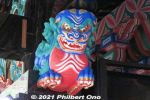
One of the lion dogs on Karamon Gate. Brought back to life from a drab-looking brown. It's part of a wooden protrusion called the "kibana" (木鼻).
|
|
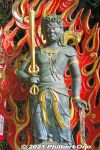
Fudō Myōō (Acala) on Chikubushima. 不動明王
|
|
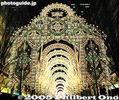
Entrance. The entrance gate is 22 meters tall and 19 meters wide.
|
|

Street corner sculpture of a couple in love. Perhaps in reference to a romantic "date."
|
|

Exterior of Great Buddha, Kamakura
|
|

Great Buddha, Kamakura
|
|

Daibutsu Great Buddha, Kamakura
|
|

Giant loach in front of the hall in Yasugi, Shimane.
|
|

Boy monk with eyeglasses at Eigenji Temple, Shiga.
|
|

While traveling, St. Shinran was unable to cross the Echigawa River since there was a flood. So he stayed at this temple temporarily. During that time, he planted a plum tree which bloom red plum blossoms.
|
|

Statue of Matsuo Basho, haiku poet. Koto-ku, Tokyo
|
|

Statue of Matsuo Basho, haiku poet. Koto-ku, Tokyo
|
|

Statue of Basho sitting at the site of Saito-an house. 採茶庵跡
|
|

Statue of Basho sitting at the site of Saito-an house before departing for the Tohoku region. 採茶庵跡
|
|

Statue of Matsuo Basho.
|
|
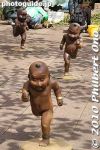
Sculpture in a park in Fuchu, Tokyo.
|
|
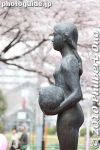
Sculpture in front of Fuchu Pool in Tokyo.
|
|
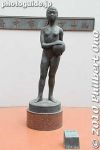
Sculpture in front of Fuchu Pool in Tokyo.
|
|

The famous giant tortoise at Gesshoji Temple, Matsue. They put a stone pillar on its back so it wouldn't walk around at night and wreak havoc. Animal cruelty?
|
|

The famous giant tortoise at Gesshoji Temple, Matsue.
|
|
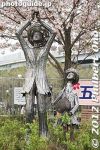
Sculpture of kids catching butterflies along Arakawa River in Adachi, Tokyo.
|
|
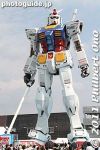
He turns his head back.
|
|
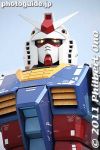
Unfortunately, he couldn't walk or fly.
|
|
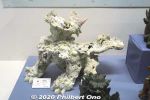
In Okinawa Culture Museum, Shisa made of coral.
|
|
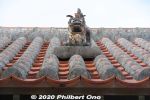
Shisa (シーサー) guardian lion dog statue on the roof to ward off evil spirits at Okinawa World.
|
|

Sculpture by Okamoto Taro at Sukiyabashi near Ginza.
|
|

Handa Dashi Matsuri float in Handa, Aichi.
|
|

Handa Dashi Matsuri float in Handa, Aichi.
|
|

Handa Dashi Matsuri float in Handa, Aichi.
|
|
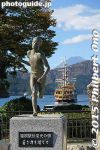
Sculpture of a Hakone Ekiden runner at Hakone-machi Port.
|
|

Statue of Lord Ii Naomasa (井伊 直政 1561-1602 ) in front of JR Hikone Station in 2007.
|
|
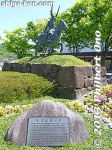
Statue of Lord Ii Naomasa (井伊 直政 1561-1602 ) in front of JR Hikone Station. One of the four great generals (徳川四天王) who helped Tokugawa Ieyasu win the Battle of Sekigahara (関ヶ原合戦) in 1600 to unify Japan and become shogun.
|
|
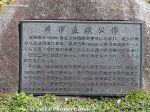
Ieyasu rewarded Naomasa with the strategic domain of Hikone (mainly Hikone, Maibara, Nagahama, Taga), making Naomasa the first Hikone daimyo (feudal lord 大名) in Omi Province (近江国).
|
|
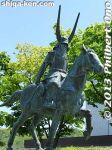
Sawayama Castle (佐和山城) came with the domain, but Naomasa did not like it, being outdated and the former castle of Ishida Mitsunari (石田 三成) who lost at Sekigahara.
|
|
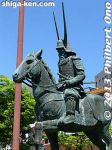
Naomasa planned to build a new castle, but died in 1602 from an old Sekigahara gunshot wound before construction began.
|
|

In front of Hikone Station, welcome banners for Hikone Castle's 400th anniversary in 2007 surround a statue of Ii Naomasa.
|
|
|
|

Statue of Ii Naomasa in front of Hikone Station
|
|

Hitsujigaoka Observation Hill's lookout deck.
|
|

"Boys, Be Ambitious" This famous statue of Dr. William Clark was built in 1976 to mark Dr. Clark's 100th anniversary of his coming to Hokkaido, the 100th anniversary of Hokkaido University's founding, and the USA bicentennial.
|
|

Dr. William S. Clark (1826-1886) was a professor from Massachusetts. The statue was made by a Japanese sculpturer and sponsored by the Sapporo Tourist Association. Hokkaido University has a bust of Dr. Clark which is also popular among tourists.
|
|

Clark came to Hokkaido for 8 months during 1876 to 1877 as a founding vice president of Sapporo Agricultural College (now Hokkaido University). When he departed, he supposedly said, "Boys, be ambitious!" to the students seeing him off.
|
|

Scale model of the Iolani Palace made of wood, painted white. Built for the 33rd Sapporo Snow Festival in 1982. The palace is in Honolulu, Hawaii, built by King David Kalakaua in 1882.
|
|
|

Girl and Sheep sculpture at Hitsujigaoka Observation Hill, Sapporo, Hokkaido
|
|

Seated Buddha statue inside Ryotanji's main hall in Iinoya, Hamamatsu.
|
|

Statue of Lord Yamauchi Kazutoyo and Chiyo near Sakata Station in Maibara, Shiga. Unveiled on May 7, 2005. 「なでしこ」山内一豊と千代
|
|
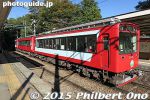
Hakone Open-Air Museum is near Chokoku no Mori Station on the Hakone Tozan Railway.
|
|
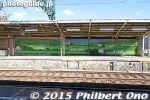
Chokoku no Mori Station on the Hakone Tozan Railway has a nice mural of the Open-Air Museum.
|
|
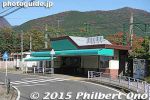
Chokoku no Mori Station on the Hakone Tozan Railway.
|
|
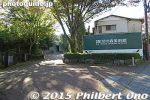
Way to Hakone Open-Air Museum. It opened in 1969 and operated under the Fujisankei Communications Group.
|
|

About Hakone Open-Air Museum. Allow at least 2 hours here.
|
|

Large, outdoor museum of exquisite sculptures. Many nudes (female). Also see the Picasso Pavilion. Both the art and 70,000-sq. meter garden-like grounds are very impressive.
|
|
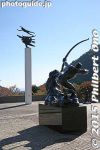
The first thing you see. Hercules and Pegasus. About 100 outdoor sculptures.
|
|
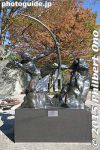
Hercules
|
|
|
|
|
|
|
|
|
|
|
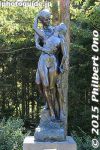
Hakone Open-Air Museum. Well worth a visit. But I wouldn't bring young children. Too many erotic/nude sculptures, mostly female.
|
|
|
|
|
|
|
|
|
|
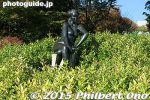
Nude near the Picasso Pavilion.
|
|
|
|

Hakone Open-Air Museum
|
|
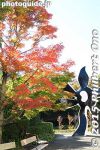
Maple leaves behind a Picasso sculpture in front of the Picasso Pavilion. Hakone is colder than Tokyo, but the cold autumn air feels great. It's a different kind of cold air that is refreshing and invigorating compared to urban Tokyo.
|
|
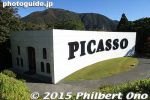
Picasso Pavilion has 300 works.
|
|
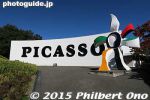
Picasso Pavilion
|
|
|
|
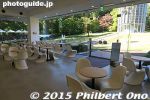
Cafe and Gallery
|
|
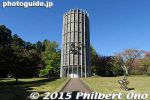
Also impressive was this stained glass tower named Symphonic Sculpture by Gabriel Loire.
|
|
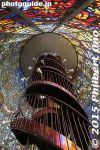
Inside Symphonic Sculpture by Gabriel Loire. You can go up the spiral staircase to the top.
|
|
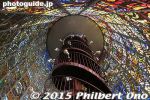
Inside Symphonic Sculpture by Gabriel Loire at Hakone Open-Air Museum.
|
|
|
|
|
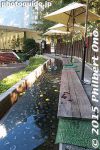
Hot spring foot bath (free)
|
|

Many Henry Moore sculptures too.
|
|
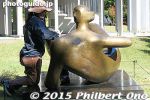
Cleaning a Henry Moore. Everything is well maintained.
|
|
|
|
|
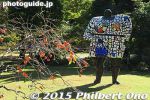
This giant piece is titled, "Miss Black Power" by French artist Niki de Saint Phalle in 1968.
|
|
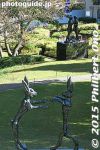
Boxing rabbits
|
|
|
|
|
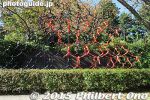
Hakone Open-Air Museum
|
|
|
|
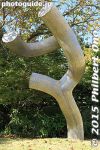
Sturm, Stainless steel piece
|
|
|
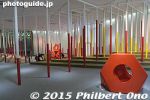
Art Hall Manzu Room
|
|
|

Museum exit
|
|
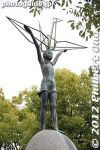
Children's Peace Monument, Hiroshima
|
|
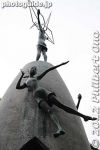
Rear of Children's Peace Monument, Hiroshima.
|
|
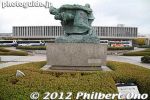
Front of the Hiroshima Peace Memorial Museum (opposite side from the Cenotaph) and Statue of Mother and Child in the Storm.
|
|
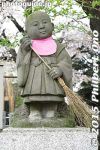
Boy priest sweeping at Ikegami Honmonji, Tokyo.
|
|

Statue of Rikidozan (1924-1963) at his grave at Ikegami Honmonji temple, Tokyo. He was a sumo wrestler until 1950 before becoming a pro wrestler.
|
|
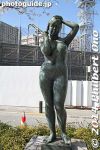
Nude sculpture at Chidorigafuchi Moat, Imperial Palace, Tokyo.
|
|

Statue of Lord Takatora Todo, who became the 11th lord of the castle in 1608. He is revered for revamping the castle and developing the castle town of Tsu. He was originally from Inugami, Shiga Pref. This statue was built in 1998.
|
|
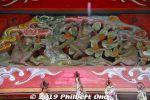
Hanazono Shrine also has a version of the three monkeys here on the Honden shrine hall, but only half the mouth, only one ear, and only one eye are covered as you can see here.
|
|
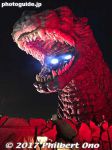
Godzilla's roaring time. On a rooftop in Kabukicho, Shinjuku.
|
|
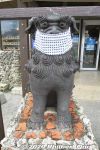
Seesa lion dog with mask, Ishigaki.
|
|

Kishima Shrine has koma-neko cat guardians because silk farmers in the 19th century kept cats to protect their precious silkworms and cocoons from rats. Rats were a major problem for the silk industry.They ate the silk cocoons and worms. So cats saved the local silk industry.
The left cat is the mother (holding a kitten), and right cat is the father. Also respectively "A" and "un."
These koma-neko cat guardian statues were donated in 1832 by silk merchants and wholesalers such as the Tonomura family (外村家一族、岩滝のちりめん問屋、山家屋の小室利七) who were textile merchants from Higashi-Omi (Gokasho), Shiga Prefecture.狛猫
|
|
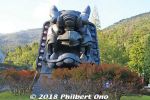
Right outside the oni museum is the world's largest oni-gawara oni roof ornament, 5 meters high, weighing 10 tons. Named "Oeyama Heisei no Dai-Oni." (大江山平成の大鬼).Japanese Oni Exchange Museum in Fukuchiyama, Kyoto Prefecture.
|
|
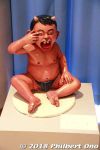
Child demon (バジ鬼) from Bali, Indonesia. Protects children from danger by warning them if they are in danger.Japanese Oni Exchange Museum in Fukuchiyama, Kyoto Prefecture.
|
|
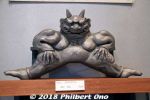
Kawara roof oni ornament.Japanese Oni Exchange Museum in Fukuchiyama, Kyoto Prefecture.
|
|
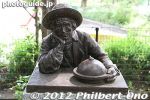
Kodaira Green Road is also noted for sculptures along the way by Kodaira-native Saito Sogan (1889-1974). This is Natural Scientist. 自然科学者
|
|
| 984 files on 4 page(s) |
1 |
 |
|